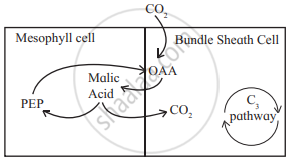Advertisements
Advertisements
Question
Correct the pathway and name it.

Solution
The pathway shown is C4 pathway.
M. D. Hatch and C. R. Slack while working on sugarcane found four-carbon compounds (dicarboxylic acid) as the first stable product of photosynthesis.
It occurs in tropical and sub-tropical grasses and some dicotyledons.
The first product of this cycle is a 4-carbon compound oxaloacetic acid. Hence it is also called as C4 pathway and plants are called C4 plants. Mechanism:
- CO2 taken from the atmosphere is accepted by a 3-carbon compound, phosphoenolpyruvic acid in the chloroplasts of mesophyll cells, leading to the formation of 4-C compound, oxaloacetic acid with the help of enzyme phosphoenolpyruvate carboxylase.
- It is converted to another 4-C compound, malic acid.
- It is transported to the chloroplasts of bundle sheath cells.
- Malic acid (4-C) is converted to pyruvic acid (3-C) with the release of CO2 in the cytoplasm.
- Thus, the concentration of CO2 increases in the bundle sheath cells.
- Chloroplasts of these cells contain enzymes of the Calvin cycle.
- Because of the high concentration of CO2, RuBP carboxylase participates in the Calvin cycle and not photorespiration.
- Sugar formed in the Calvin cycle is transported into the phloem.
- Pyruvic acid generated in the bundle sheath cells re-enter mesophyll cells and regenerates phosphoenolpyruvic acid by consuming one ATP.
- Since this conversion results in the formation of AMP (not ADP), two ATP are required to regenerate ATP from AMP.
- Thus, C4 pathway needs 12 additional ATP.
- The C3 pathway requires 18 ATP for the synthesis of one glucose molecule, whereas C4 pathway requires 30 ATP. Thus, C4 plants are better photosynthesizers as compared to C3 plants as there is no photorespiration in these plants.
APPEARS IN
RELATED QUESTIONS
The head and tail of chlorophyll are made up of ______.
C4 pathway is also called as dicarboxylation pathway because ______.
Answer the following question.
What are the steps that are common to C3 and C4 photosynthesis?
Answer the following question.
Why are plants that consume more than the usual 18 ATP to produce 1 molecule of glucose favoured in tropical regions?
Answer the following question.
In C-4 plants, why is C-3 pathway operated in bundle sheath cells only?
Answer the following question.
What would have happed if C-4 plants did not have Kranz anatomy?
Answer the following question.
Why does RuBisCO carry out preferentially carboxylation than oxygenation in C4 plants?
Answer the following question.
How can you identify whether the plant is C3 or C4? Explain / Justify.
Answer the following question.
In C4 plants, bundle sheath cells carrying out the Calvin cycle are very few in number. Then also, C4 plants are highly productive. Explain.
Where does the conversion of pyruvic acid into phosphoenol pyruvic acid take place?
